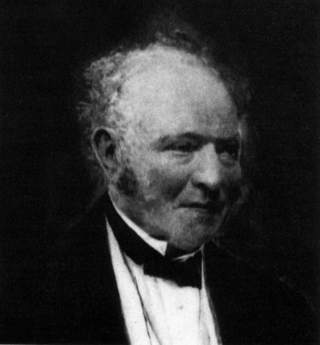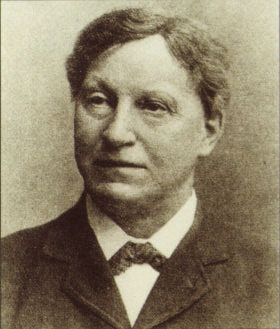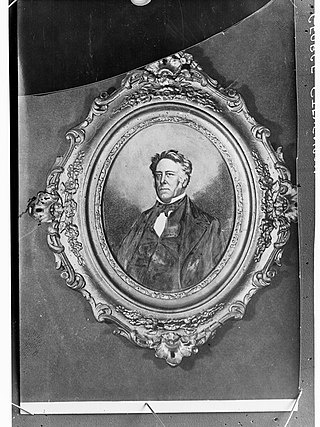Ninian Niven | |
|---|---|
 | |
| Born | 1799 Kelvingrove, Glasgow, Scotland |
| Died | 18 February 1879 (aged 79–80) Drumcondra, Dublin, Ireland |
Ninian Niven (1799 - 18 February 1879) was a Scottish horticulturist and landscape gardener. [1]
Ninian Niven | |
|---|---|
 | |
| Born | 1799 Kelvingrove, Glasgow, Scotland |
| Died | 18 February 1879 (aged 79–80) Drumcondra, Dublin, Ireland |
Ninian Niven (1799 - 18 February 1879) was a Scottish horticulturist and landscape gardener. [1]
Ninian Niven was born in 1799 in Kelvingrove, Glasgow. His father, also Ninian Niven, was a gardener at Keir House near Stirling, and travelled to the Cape of Good Hope twice collecting plants for George Hibbert and the Empress Josephine of France. Niven was schooled in Glasgow, and was apprenticed as a gardener at Bothwell Castle under Thomas Butler. [2] He planned to become a plant collector, and studied plant drawing and painting after his apprenticeship. He returned to Bothwell for a time, and in 1822 he moved to Belladrum House, Inverness-shire. [1]
Niven married Agnes Craig. One son, Francis Wilson, emigrated to Victoria, Australia and became a printer. [3] Another son, James Craig (1828–1881), was a gardener in Belfast Botanic Gardens from 1843 and Kew Gardens from 1846, and went on to become curator of Hull Botanic Garden in 1855. [1]
Niven was invited to take up the position of head gardener of the grounds of the official residence of the chief secretary for Ireland in the Phoenix Park, Dublin in 1827. Over the course of 8 years he developed his landscaping skills and remodelled the garden. In March 1834 he became the curator of the Botanic Gardens, Glasnevin. Here he concentrated his efforts on expanding the plant collection, as well as restoring and improving the layout of the neglected gardens. In 1838 he published his Visitor's companion to the Botanic Gardens. Four years after his appointment, visitor numbers had risen from 7,000 a year to over 20,000. He also established the first horticultural training courses at the gardens, which are still a feature of the gardens' work. [1] [4]
He resigned from the Botanic Gardens in October 1838, [4] and established the Garden Farm nursery in Clonturk Lodge, Drumcondra, Dublin. This nursery specialised in vines and fruit trees. Niven also ran horticultural courses from his home at Sandycourt, Drumcondra. As a landscape designer, he designed the gardens of many Irish country houses, influenced by his visit to France in the 1830s. In the Phoenix Park alone he designed the gardens of the viceregal lodge, chief secretary's lodge, and under-secretary's lodge as well as the People's Garden there. He also designed the Iveagh Gardens for the great exhibition of 1865, and Hilton Park, Clones, County Monaghan in 1870. [1] He also drew and painted plants for publication such as the Botanist. [4]
Niven was an active member of the Royal Horticultural Society, serving as secretary from 1847 to 1853. He was also an associate of the Linnean Society. He wrote a number of articles for gardening periodicals. He won a silver medal from the Royal Dublin Society in 1835 for an essay on the potato crop failure. During the Great Famine, he published a pamphlet, The potato epidemic and its probable consequences, in the form of an open letter to Augustus FitzGerald, 3rd Duke of Leinster. He mistakenly attributed the cause of the potato disease to atmospheric conditions, unlike David Moore, who correctly deduced the cause of the blight. In 1869 he published a volume of poems, Redemption thoughts. [1]
He worked in his garden at Garden Farm until the day he died, on 18 February 1879. [1]

The National Botanic Gardens is a botanical garden in Glasnevin, 5 km north-west of Dublin city centre, Ireland. The 19.5 hectares are situated between Glasnevin Cemetery and the River Tolka where it forms part of the river's floodplain.

The Birmingham Botanical Gardens are a 15-acre (6-hectare) botanical garden situated in Edgbaston, Birmingham, England. The gardens are located 1+1⁄2 miles (2.4 km) south-west of Birmingham city centre at grid reference SP049854. Designed in 1829, the gardens are Grade II* listed in Historic Englands's Register of Parks and Gardens, and retain many original features and layout, which was designed by the landscape gardener and horticulturalist John Claudius Loudon. The site is notable for its range of glasshouses and gardens, which display a wide variety of plants and birds. Birmingham Botanical Gardens is managed by Birmingham Botanical and Horticultural Society, a registered charity. The gardens are open daily to the public with paid admission.

Richard Turner (1798–1881) was an Irish iron founder and manufacturer of glasshouses, born in Dublin. He is rated as one of the most important glasshouse designers of his time. His works included the Palm House at Kew Gardens, the glasshouse in the Winter Gardens at Regent's Park in London, the Palm House at Belfast Botanic Gardens and the Curvilinear Range at the Irish National Botanic Gardens, Glasnevin, Ireland.

John Lindley FRS was an English botanist, gardener and orchidologist.

Belvedere House and Gardens is a country house located approximately 8 kilometres (5 mi) from Mullingar, County Westmeath in Ireland on the north-east shore of Lough Ennell. It was built in 1740 as a hunting lodge for Robert Rochfort, 1st Earl of Belvedere by architect Richard Cassels, one of Ireland's foremost Palladian architects.
A plantsman is an enthusiastic and knowledgeable gardener, nurseryman or nurserywoman. "Plantsman" can refer to a male or female person, though the terms plantswoman, or even plantsperson, are sometimes used. The word is sometimes said to be synonymous with "botanist" or "horticulturist", but that would indicate a professional involvement, whereas "plantsman" reflects an attitude to plants. A horticulturist may be a plantsman, but a plantsman is not necessarily a horticulturist.

Frederick William Thomas Burbidge (1847–1905) was a British explorer who collected many rare tropical plants for the famous Veitch Nurseries.

George Stevenson was a pioneer South Australian newspaper editor and horticulturist. He came to Adelaide as private secretary to the first Governor of South Australia, John Hindmarsh.
Thomas Moore was a British gardener and botanist. An expert on ferns and fern allies from the British Isles, he served as Curator of the Society of Apothecaries Garden from 1848 to 1887. In 1855 he authored The Ferns of Great Britain and Ireland. The standard author abbreviation T.Moore is used to indicate this person as the author when citing a botanical name.

James Herbert Veitch F.L.S., F.R.H.S., was a member of the Veitch family who were distinguished horticulturists and nursery-men for over a century.

The Penang Botanic Gardens, also known as the "Waterfall Gardens" because of the cascading waterfall nearby, is a botanic garden situated on Jalan Air Terjun in George Town, Penang, Malaysia.

James MacFadyen (1799–1850) was a Scottish doctor and botanist who made a significant contribution to the scientific study of the plants of the Caribbean region. Born in Glasgow on 3 May 1799, he was the eldest son of a music publisher and bookseller, John Macfadyen, and his wife Elisabeth. Macfayden was the first to describe the grapefruit scientifically - he gave it its Linnean name, Citrus paradisi - and to describe new species of fig trees and other Caribbean plants. In addition to his contributions to botany, MacFayden practiced medicine and was actively involved in social organisations in Jamaica. He was elected Fellow of the Linnean Society of London on 16 January 1838 and (posthumously) Fellow of the Geological Society of London on 30 November 1850. On 25 November 1832 in Port Royal he married Margaret McGowan, by whom he had two daughters. After his wife's death on 21 June 1843, he married Emma, by whom he had a son and a daughter. Whilst treating patients during one of the periodic epidemics of cholera there, he himself contracted the disease and died on 24 November 1850.

Charles Moore was an Australian botanist and director of the Royal Botanic Garden, Sydney.

Lee and Kennedy were two families of prominent Scottish nurserymen in partnership for three generations at the Vineyard Nursery in Hammersmith, west of London. "For many years," wrote John Claudius Loudon in 1854, "this nursery was deservedly considered the first in the world."
John Graefer or Johann Andreas Graeffer was a German botanist nurseryman born in Helmstedt. Graeffer/Graefer is remembered by garden historians as having introduced a number of exotic plants to British gardens and to have worked for the king of Naples at the palace of Caserta.
Walter Wade, MD was an Irish physician and botanist. He was the first professor of botany at the National Botanic Gardens of Ireland.

David Moore was a Scottish botanist who served as director of the Irish National Botanic Gardens for over 40 years.

Killakee House was a large Georgian house and estate near Rathfarnham in County Dublin, Ireland. It was built in c.1806 for Luke White, an Irish politician and bookseller and was the centrepiece of a 3,400-acre estate, but was demolished in 1941 after many years of vacancy.
William Masters (1796–1874) FHS was an English nurseryman, garden designer, and amateur botanist. Born at Canterbury on 7 July 1796, he founded a nursery in St. Peter's St., Canterbury, initially known as St Peter's Nursery Ground, later as Master's Botanical Garden and Nursery Ground, and later still as Master's Exotic Nursery. Masters specialized in the cultivation of exotic plants, and experimental hybridizations. He also founded the Canterbury Museum, of which he was Hon. Curator from 1823 to 1846. Masters replanted much of the Dane John Gardens in Canterbury with stock donated from his nursery, and also designed several of the terraces in the middle of the formal garden at Walmer Castle. However, Masters is chiefly remembered for his catalogue Hortus duroverni of 1831, which comprehensively listed and classified many seeds and plants. One of his introductions, the elm cultivar Ulmus × hollandica 'Superba', commonly known as the Canterbury Elm, became very popular as a street tree, notably in Germany, where it was propagated by the Spath nursery, Berlin.

Sir Frederick William Moore, was President of the Royal Horticultural Society of Ireland, and Keeper of the Royal Botanical Gardens, Dublin in the period 1879-1922.